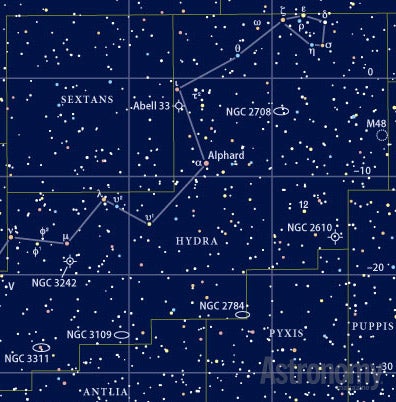Targets for March 17–24, 2016
Small telescope: The Golden Earring (NGC 2547)
Large telescope: Planetary nebula NGC 2867
Large telescope: Barred spiral galaxy NGC 3109
Not the Twilight Zone
This week’s small-telescope target is the Golden Earring, otherwise known as open cluster NGC 2547 in the southern constellation Vela the Sails.
Oh, my! Here’s a gorgeous object that, unfortunately, many Northern Hemisphere observers have never seen. At magnitude 4.7, NGC 2547 is easily visible to the naked eye from a dark site. It lies in a dense star field 1.9° south of magnitude 1.7 Regor (Gamma [γ] Velorum).
Through any size telescope, you’ll see a dozen stars that shine at magnitude 9 or brighter. The brightest is magnitude 6.5 SAO 219538, which sits just to the east of cluster’s center.
Because of the richness of the surrounding star field, you’ll have trouble following the cluster’s boundary to its very limit. Still, what you detect will span a diameter of 74′ — more than 5½ times the area of the Full Moon.
Astronomy magazine Contributing Editor Stephen James O’Meara coined the common name (among others) for this cluster from a drawing by Australian astronomer James Dunlop, who lived in the first half of the 19th century. Dunlop drew the cluster as an oval of stars dangling from two rows of parallel stars. O’Meara likened the image to a golden earring dangling from a pirate’s ear.
A nice catch
This week’s first large-scope object is planetary nebula NGC 2867 in Carina the Keel. Sir Patrick Moore included this object in his Caldwell catalog as number 90.
You’ll find this target 1.1° north-northeast of magnitude 2.2 Aspidiske (Iota [ι] Carinae). This bright planetary — magnitude 9.7 is bright for this class of object — will take all the magnification you can throw at it.
Through 4-inch and larger telescopes, NGC 2867 appears robin’s-egg blue to most observers. It has a diameter of 11″, which is only a couple of arcseconds smaller than how Mars appeared at its largest in 2012.
A 12-inch scope at 300x reveals a bright edge with an ever-so-slightly darker central region. A magnitude 10.2 star lies a bit more than 2″ east of the nebula.
A big neighbor
This week’s second large-telescope target is barred spiral galaxy NGC 3109 in the constellation Hydra the Water Snake. To find it, point your telescope 7.2° northwest of magnitude 4.3 Alpha (α) Antliae.
This nearby barred spiral galaxy belongs to the Local Group. Through a 6-inch telescope, NGC 3109 appears as a faint mist measuring three to four times longer than it is wide, but you’ll need to be under a really dark sky to see it through that aperture. The galaxy’s full extent is 16′ by 2.9′. A 16-inch scope will reveal a surface punctuated with knots of unresolved stars and clouds of ionized hydrogen. The galaxy boasts a magnitude of 9.8, but remember that it’s huge, so its surface brightness is low.
Expand your observing at Astronomy.com
The Sky this Week
Get a daily digest of celestial events coming soon to a sky near you.
Observing Basics
Find more guidance from Senior Editor Michael E. Bakich with his Observing Basics video series.










